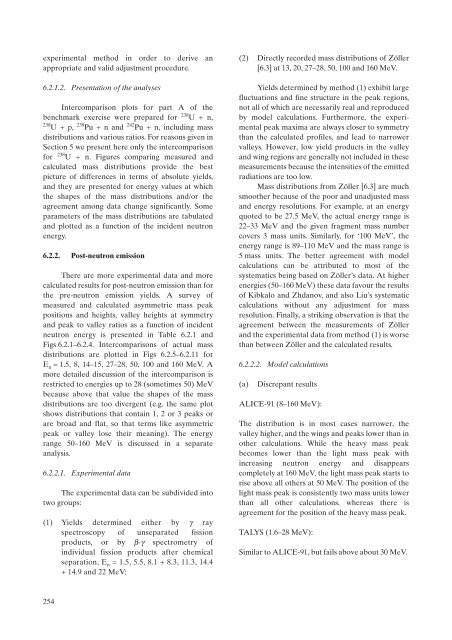Fission Product Yield Data for the Transmutation of Minor Actinide ...
Fission Product Yield Data for the Transmutation of Minor Actinide ...
Fission Product Yield Data for the Transmutation of Minor Actinide ...
Create successful ePaper yourself
Turn your PDF publications into a flip-book with our unique Google optimized e-Paper software.
experimental method in order to derive an<br />
appropriate and valid adjustment procedure.<br />
6.2.1.2. Presentation <strong>of</strong> <strong>the</strong> analyses<br />
Intercomparison plots <strong>for</strong> part A <strong>of</strong> <strong>the</strong><br />
benchmark exercise were prepared <strong>for</strong> 238 U + n,<br />
238 U + p, 239 Pu + n and 242 Pu + n, including mass<br />
distributions and various ratios. For reasons given in<br />
Section 5 we present here only <strong>the</strong> intercomparison<br />
<strong>for</strong> 238 U + n. Figures comparing measured and<br />
calculated mass distributions provide <strong>the</strong> best<br />
picture <strong>of</strong> differences in terms <strong>of</strong> absolute yields,<br />
and <strong>the</strong>y are presented <strong>for</strong> energy values at which<br />
<strong>the</strong> shapes <strong>of</strong> <strong>the</strong> mass distributions and/or <strong>the</strong><br />
agreement among data change significantly. Some<br />
parameters <strong>of</strong> <strong>the</strong> mass distributions are tabulated<br />
and plotted as a function <strong>of</strong> <strong>the</strong> incident neutron<br />
energy.<br />
6.2.2. Post-neutron emission<br />
There are more experimental data and more<br />
calculated results <strong>for</strong> post-neutron emission than <strong>for</strong><br />
<strong>the</strong> pre-neutron emission yields. A survey <strong>of</strong><br />
measured and calculated asymmetric mass peak<br />
positions and heights, valley heights at symmetry<br />
and peak to valley ratios as a function <strong>of</strong> incident<br />
neutron energy is presented in Table 6.2.1 and<br />
Figs 6.2.1–6.2.4. Intercomparisons <strong>of</strong> actual mass<br />
distributions are plotted in Figs 6.2.5–6.2.11 <strong>for</strong><br />
E n = 1.5, 8, 14–15, 27–28, 50, 100 and 160 MeV. A<br />
more detailed discussion <strong>of</strong> <strong>the</strong> intercomparison is<br />
restricted to energies up to 28 (sometimes 50) MeV<br />
because above that value <strong>the</strong> shapes <strong>of</strong> <strong>the</strong> mass<br />
distributions are too divergent (e.g. <strong>the</strong> same plot<br />
shows distributions that contain 1, 2 or 3 peaks or<br />
are broad and flat, so that terms like asymmetric<br />
peak or valley lose <strong>the</strong>ir meaning). The energy<br />
range 50–160 MeV is discussed in a separate<br />
analysis.<br />
6.2.2.1. Experimental data<br />
The experimental data can be subdivided into<br />
two groups:<br />
(1) <strong>Yield</strong>s determined ei<strong>the</strong>r by g ray<br />
spectroscopy <strong>of</strong> unseparated fission<br />
products, or by b-g spectrometry <strong>of</strong><br />
individual fission products after chemical<br />
separation, E n = 1.5, 5.5, 8.1 + 8.3, 11.3, 14.4<br />
+ 14.9 and 22 MeV;<br />
254<br />
(2) Directly recorded mass distributions <strong>of</strong> Zöller<br />
[6.3] at 13, 20, 27–28, 50, 100 and 160 MeV.<br />
<strong>Yield</strong>s determined by method (1) exhibit large<br />
fluctuations and fine structure in <strong>the</strong> peak regions,<br />
not all <strong>of</strong> which are necessarily real and reproduced<br />
by model calculations. Fur<strong>the</strong>rmore, <strong>the</strong> experimental<br />
peak maxima are always closer to symmetry<br />
than <strong>the</strong> calculated pr<strong>of</strong>iles, and lead to narrower<br />
valleys. However, low yield products in <strong>the</strong> valley<br />
and wing regions are generally not included in <strong>the</strong>se<br />
measurements because <strong>the</strong> intensities <strong>of</strong> <strong>the</strong> emitted<br />
radiations are too low.<br />
Mass distributions from Zöller [6.3] are much<br />
smoo<strong>the</strong>r because <strong>of</strong> <strong>the</strong> poor and unadjusted mass<br />
and energy resolutions. For example, at an energy<br />
quoted to be 27.5 MeV, <strong>the</strong> actual energy range is<br />
22–33 MeV and <strong>the</strong> given fragment mass number<br />
covers 3 mass units. Similarly, <strong>for</strong> ‘100 MeV’, <strong>the</strong><br />
energy range is 89–110 MeV and <strong>the</strong> mass range is<br />
5 mass units. The better agreement with model<br />
calculations can be attributed to most <strong>of</strong> <strong>the</strong><br />
systematics being based on Zöller’s data. At higher<br />
energies (50–160 MeV) <strong>the</strong>se data favour <strong>the</strong> results<br />
<strong>of</strong> Kibkalo and Zhdanov, and also Liu’s systematic<br />
calculations without any adjustment <strong>for</strong> mass<br />
resolution. Finally, a striking observation is that <strong>the</strong><br />
agreement between <strong>the</strong> measurements <strong>of</strong> Zöller<br />
and <strong>the</strong> experimental data from method (1) is worse<br />
than between Zöller and <strong>the</strong> calculated results.<br />
6.2.2.2. Model calculations<br />
(a) Discrepant results<br />
ALICE-91 (8–160 MeV):<br />
The distribution is in most cases narrower, <strong>the</strong><br />
valley higher, and <strong>the</strong> wings and peaks lower than in<br />
o<strong>the</strong>r calculations. While <strong>the</strong> heavy mass peak<br />
becomes lower than <strong>the</strong> light mass peak with<br />
increasing neutron energy and disappears<br />
completely at 160 MeV, <strong>the</strong> light mass peak starts to<br />
rise above all o<strong>the</strong>rs at 50 MeV. The position <strong>of</strong> <strong>the</strong><br />
light mass peak is consistently two mass units lower<br />
than all o<strong>the</strong>r calculations, whereas <strong>the</strong>re is<br />
agreement <strong>for</strong> <strong>the</strong> position <strong>of</strong> <strong>the</strong> heavy mass peak.<br />
TALYS (1.6–28 MeV):<br />
Similar to ALICE-91, but fails above about 30 MeV.

















